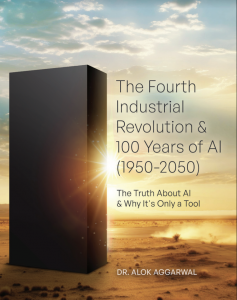
An excerpt from Alok Aggarwal’s new book explores the impact of Artificial Intelligence on industries worldwide
— Alok Aggarwal
SAN JOSE, CALIFORNIA, USA, February 29, 2024 /EINPresswire.com/ — The fifth chapter of Dr. Alok Aggarwal’s new book, “The Fourth Industrial Revolution & 100 Years of AI (1950-2050)“, titled “Internet of Things, Smart Cities, Data, and AI,” discusses how Internet of Things (IoT) and AI are being combined to provide superior results in almost all industries worldwide.
IoT, a vast network of interconnected electronic devices, encompasses sensors, actuators, cameras, RFID tags, and more, all linked to the Internet or Intranets. Originating in 1982 when a Coca-Cola vending machine was connected to the Internet, IoT evolved significantly, with Peter Lewis formally defining it in 1985. Today, IoT extends beyond its original scope to the Internet of Everything (IoE), embracing devices, machines, living beings, and non-living objects with unique identifiers, fostering communication without human intervention.
Below are the key takeaways from this chapter:
• IoT sector has been growing substantially and will continue to do so: During the last twelve years, IoT sector has been growing substantially and it will become vital for almost all sectors particularly those related to manufacturing, supply chain, healthcare, and consumer-related fields.
• IoT and AI comprise a match made in heaven: IoT devices already produce humungous amounts of data that is being collated, harmonized, and analyzed for optimizing various aspects of human endeavor. Indeed, this data in conjunction with other structured and unstructured data is already becoming a crucial part of our infrastructure in the current industrial revolution and it will help in training AI systems better.
• IoT-AI combination will make cities more efficient: Smart Cities will depend critically on IoT-AI combination and the following six sectors will make them extremely efficient and environment friendly – (a) green buildings, (b) climate-smart water and wastewater management infrastructure, (c) public transportation, (d) electric vehicles, (e) renewable energy, and (f) reducing waste and recycling it.
• Current IoT implementations have significant impediments: Because of the following impediments, the annual growth rates may be substantially less than what some market research suggests – (a) insufficient connectivity via internet and intranets, (b) gaps in transmitted data by IoT devices, (c) lack of interoperability among devices and protocols, and (d) concerns regarding cybersecurity and privacy. Moreover, as mentioned in the first chapter, new technology takes significant time to seep deeply into human society, and the IoT sector will be no different. Although IoT may take fifteen or more years to become pervasive, once it seeps into the society, its effects will be far and wide, and considerably more than those imagined now.
• The IoT sector is going through a hype cycle, which may be advantageous in the long run: Although the extensive hype regarding the growth of the IoT sector is likely to fizzle out, hopefully, during this boom-bust cycle, a new infrastructure related to IoT will be created just like what occurred in the second and third revolutions with railroads and electronic communication.
Overall, the book, “The Fourth Industrial Revolution & 100 Years of AI (1950-2050)” provides a concise yet comprehensive exploration of AI, covering its origins, evolutionary trajectory, and its potential ubiquity during the next 27 years. Beginning with an introduction to the fundamental concepts of AI, subsequent chapters delve into its transformative journey with an in-depth analysis of achievements of AI, with a special focus on the potential for job loss and gain. The latter portions of the book examine the limitations of AI, the pivotal role of data in enabling accurate AI systems, and the concept of “good” AI systems. It concludes by contemplating the future of AI, addressing the limitations of classical computing, and exploring alternative technologies (such as Quantum. Photonics, Graphene, and Neuromorphic computing) for ongoing advancements in the field. This book is now available in bookstores and online retailers in Kindle, paperback, and hard cover formats.
About the Author and Scry AI: Dr. Aggarwal is the founder, CEO, and Chief Data Scientist of Scry AI, which provides innovative AI-based products, solutions, and services to enterprises across the globe. Before starting Scry AI, he co-founded Evalueserve (www.evalueserve.com) which provides research and analytics services worldwide. He received his Ph. D. from Johns Hopkins University and worked at IBM’s T. J. Watson Research Center during 1984 and 2000. He has written more than 120 research articles and has been granted eight patents.
Scry AI is a research and development company that uses AI and Data Science to help its clients in solving complex and extremely laborious problems. Scry AI has developed more than 60 proprietary AI-based models and algorithms which constitute its CognitiveBricks platform of innovative business solutions. Scry AI’s family of enterprise solutions include: Collatio (an Intelligent Document Processing factory with unparalleled accuracy for reconciling unstructured and structured data), Anomalia (for detecting anomalies and potential fraud), Concentio (for providing actionable insights using Internet of Things’ data), Vigilo (for predicting operational and marketing risks), and Data Flow Mapping (for extracting data lineage as data flows through disparate systems). For more information, please visit: www.scryai.com
Alok Aggarwal
Scry AI, Inc.
+1 9149804717
email us here
Visit us on social media:
Facebook
Twitter
LinkedIn
Instagram
YouTube
![]()
Originally published at https://www.einpresswire.com/article/691458745/book-excerpt-internet-of-things-smart-cities-data-and-ai



